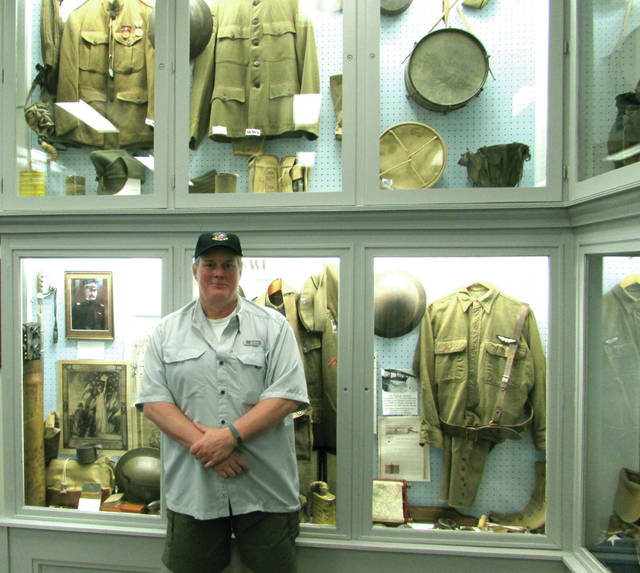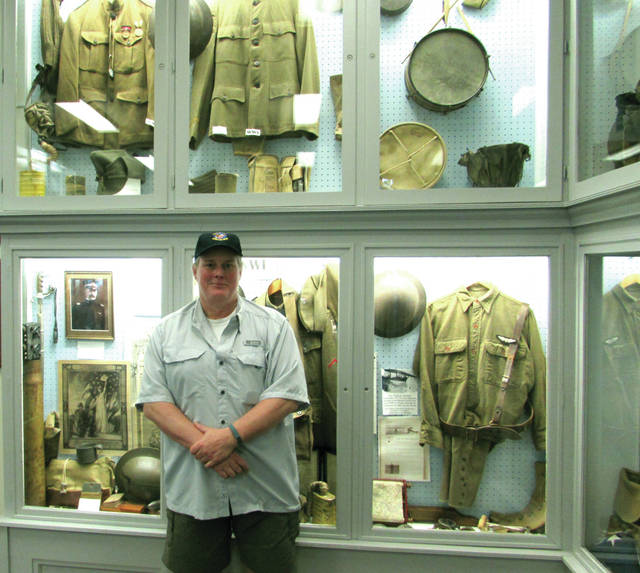

By Carolyn Harmon
GREENVILLE — When it comes to military history, Military Collections Consultant David Manges is a combination of effervescence and gravity.
Manges, of Beavercreek, volunteers on Fridays at Garst Museum, in Greenville. His focus is organizing the military history exhibits into chronological order. His skill set of enthusiasm, knowledge, military history, attention to detail, investigator and patience has made the exhibits relevant. Here is an example of his day.
“I found this photograph in the basement of the old Garst House and nobody had a clue who it was,” Manges said. “All I knew was it was the 166th Infantry, Company M. A couple of months after, I found a World War I (WWI) French to German phrase book for GIs to carry. On the back page it said (sergeant’s name), Company M, 166th Infantry from New Weston, Ohio, (which took Manges back to the picture). There are nine sergeants in the front row, so I knew he was one of those nine guys. I went to the genealogy ladies (at Garst) and they tracked down his 84-year-old-son, who picked out his father in the picture. It was the first time he had ever seen a picture of his dad in uniform. I went back and dug into the genealogy section and the Unit Chaplain had published weekly newsletters during the entirety of WWI. I have their whole unit, from initial mustering from coming back and being discharged.”
Manges is a scholar of Military History. He had worked 30 years and retired as Major out of the U.S. Army, earned a bachelor’s degree of History and Political Science, taught Reserve Officers’ Training Corps (ROTC) as Prof. of Military Science at Wright State University and earned a master’s degree of Public History. As Public History is presenting history to the public, part of his degree requirement was to complete a project at a museum. He chose Garst and did an exhibit on a War of 1812 Uniform.
“I noticed other potential projects and stayed on,” Manges said.
But long before any of that, Manges seemed to have had an innate draw to the military and history. He said he knew he was going to join the Army when he was three-years-old. At that time, before he could read, Manges brought home big military history books to his older sister for her to read to him, he said.
Which is now a service he provides at the museum – a story teller by way of chronological organization.
So far, Manges has organized the military history exhibits from the oldest, the War of 1812 to WWI. In addition, the items are being accessioned, which means put into the museum data where they are cataloged, measured, numbered and therefore searchable inventory. The older donations have come into Garst with often misleading and vague information.
“I am going through notebook papers of 50 years ago saying things like, ‘In 1974 Mrs. Smith donated a WWI Navy uniform’. ” Manges said. “Which uniform?”
Manges said Garst Museum Volunteers Norma Schilling, Carolyn Fletcher, Pat Lemmer and Peggy Wohlgamuth are very instrumental in the accessioning process. The artifacts in the military room had never been cataloged, according to Schilling. Since Manges started this project, thousands have been accessioned with many more waiting. The mysteries can be staggering.
“We had two papers for a wooden leg,” Manges said. “One was from a Civil War Veteran and the other was from a farmer who lost his leg in a farming accident. Whose leg is it? We figured out it was the Civil War Veteran. Another example, seven WWI gas masks had eight or nine identification cards. The thing about the military, everybody’s stuff looks exactly the same. Most of the guys put their name in it somewhere. If not, and if the person who donated the item doesn’t have the same name as the person who owned it, we can’t put it together.”
In addition to chronicling, Manges is doubling exhibit space by using the closed – up windows in-between the exhibits. This also cuts down on the natural light that can damage the artifacts. He is also thoughtful in the exhibit presentations, by putting things people need to read, such as letters or photos on the lower end and uniforms and guns up higher. And for the convenience of those folks that are unable to climb the stairs, Manges made a photo book full of the upstairs exhibits.
If walls could talk, those hanging on them might imaginably be most grateful for the respect they have received by David Manges and the Garst Museum staff.
“If you don’t preserve it, then it is gone,” Manges said.
For more information, visit http://www.garstmuseum.org/
The writer may be reached at 937-569-4354. Join the conversation and get updates on Facebook search Darke County Sports or Advocate 360. For more features online go to dailyadvocate.com.


